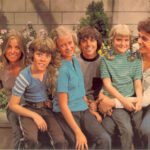Over the years, television programs have changed in order to suit the needs of an adapting audience, while still maintaining the familiar elements of specific genres. Two television shows from different time periods which I found to be quite interesting when compared and contrasted are “The Brady Bunch,” from the late sixties, and “Step by Step,” from the early nineties.
The Brady Bunch,” which aired in 1969, was a light-hearted comedy, best suited for family-viewing. “Step By Step” was a comedy that aired in 1991, intended for family and/or teenage viewers. The Brady Bunch” lasted five years, while “Step by Step” lasted seven years. As far as subject matter of both of these sitcoms, they hold very much in common. Both shows in some way revolve around the theme of two separate families coming together, forcing the children to interact as brothers and sisters, and causing many adventures, conflicts and situations to arise.
In “The Brady Bunch,” Carol and Mike Brady are both widows who come together with each of their three children (Marcia, Jan, Cindy, Greg, Peter and Bobby) to live under one roof. In “Step By Step,” Frank Lambert and Carol Foster, two former divorcees, get married to have each of their three children (JT, Al, Brendan, Dana, Mark and Karen) live in one house. Each show expressed elements of comedy but still included an element of family conflict and resolution. In essence, both shows had heart and could make you laugh. Most importantly, both sitcoms accurately portrayed conflict between siblings, and moreover, situations that kids and teenagers face growing up.
For example, in “The Brady Bunch” Jan is horrified when her mom makes her wear glasses to school, while in “Step by Step,” Mark is often considered “dorky” because of his wire-rimmed glasses and suspenders. Audiences also got to witness the changes in Peter Brady’s voice as he went through puberty, while throughout the course of “Step By Step,” people got to see all three boys experience a visual transformation as well, as they went from young boys to teenagers. Each show also features an alternate character that is not actually a member of the family, but is considered one. In “The Brady Bunch,” this character is quirky Alice, the maid, whereas in “Step by Step,” this character is Cody, the rambunctious neighbor.
Most of the difference found between the two sitcoms could arguably be due to the differences in their time periods. In general, “The Brady Bunch” seems to use more straight-forward, light-comedy, while “Step by Step” seems to use more sarcasm and wit. Set in the sixties and seventies, the Brady family tended to wear bellbottoms and crisp-collared shirts, whereas teenagers in the Lambert family dressed not too much different from the styles of today, especially in its more recent seasons. The main difference I found personally was in the content of certain situations. For example, in “The Brady Bunch,” a student hitting on Marcia in school because of her short skirt might serve as a main conflict, yet in “Step by Step,” a more realistic approach is taken to conflict, such as Al being pressured to have sex by her new boyfriend.
I think that if both of these programs were switched in their time periods, they would both not be as successful in their new settings. The “good-two-shoes,” often corny attitude of “The Brady Bunch,” would not be attractive to today’s viewers because the program would seem extremely outdated and would not relate to any issues that teenagers actually face today. “Step By Step” would not be as appealing in the seventies because its overall style in script and style of its characters are not compatible with that of the seventies generation. However, if one of these shows had to be switched, I think “Step By Step” could survive in another generation because it contains the same family/teenager issues and concepts as any other show like it.




